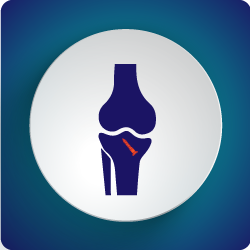
Anterior Cruciate Ligament Reconstruction
Anterior Cruciate Ligament injuries occur usually due to hyperextension of the knee or a valgus force to the knee. It occurs most often in sports people and is a common injury in footballers, soccer players and skiers. When the ligament is ruptured, often other parts of the knee are injured too, which results in pain. The ACL has a blood vessel in it, which will always rupture when the ligament ruptures. This fills the knee with blood, causing immediate swelling and pain.
The timing of ACL reconstructions is crucial. If performed too early, the blood and inflammatory cells in the knee may result in a condition called Arthrofibrosis. This results in the knee becoming stiff for an extended period of time due to scarring within the knee joint itself. This is a difficult to treat condition, so is best avoided by waiting for swelling in the knee to resolve and for range of movement to return back to close to normal.
Sometimes it is necessary to perform a knee arthroscopy before the reconstruction. This might be because the knee is extremely painful and slow to recover, or if there is other pathology that needs addressing first. This can address things like meniscal tears or cartilage injuries before performing the Anterior Cruciate Ligament reconstruction. Usually this improves the feeling of the knee. It is not always required.
An ACL reconstruction can be performed in a variety of methods. In most cases, all the techniques require drilling a bone tunnel into the tibia and the femur. The tunnels are used to accept the graft, and the graft is inserted into the knee to become a new ligament.
There are several graft choices. Dr Chien-Wen Liew utilises a hamstring graft as it has a good tensile strength, has very little donor site morbidity (i.e. negative side effects of taking it) and has a good success rate. In cases where the hamstrings have already been taken, the other graft choices are the bone-patella tendon-bone graft, or quadriceps tendon. These have their own issues, such as anterior knee pain (Pain at the front of the knee). In long term studies there is minimal effect to harvesting the hamstrings. It has been shown that the hamstrings have a slight reduction in fatigue resistance at the terminal (end) of knee flexion, however this is usually not noticed, even by high level athletes.
Even so, Dr Liew uses a refined technique called a Single Hamstring Technique. This means that only 1 of the hamstrings is used, rather than 2. The single hamstring is used in a specific way, making it as stronger, if not stronger, than 2 hamstring reconstructions. This technique is called the Graft Link technique. Dr Liew has been using this technique routinely with excellent results.
Other graft options are available. One of these is called the Lars Ligament. It is a synthetic graft, used to reduce the need to take hamstring or other graft. It has had some good early success but has recently fallen out of favour due to it having a much larger failure rate after several years. Dr Chien-Wen Liew only uses Lars Ligament grafts for certain conditions, such as multi-ligamentous knee injuries where there are not enough graft options to take autograft (graft from the person).
There are two main methods of performing an Anterior Cruciate Ligament reconstruction. One is by placing the alignment rods through the tibia. This is easiest, quickest and yields good results. Current evidence, however, suggests that this method leads to some incorrect positioning of the graft. Therefore, the preferred method is performing a method called a “Through Portal” technique. This uses independent alignment to obtain the best possible position for the anterior cruciate ligament graft.
After an ACL reconstruction, you will be given crutches and allowed to weight bear as tolerated. Your knee will be bandaged, and all bandages should remain in place until your review. Once the initial discomfort from the surgery has subsided, physiotherapy will start (Usually day 1 post op). At 3 months, you will be allowed to participate in gentle exercises, such as cycling and straight line running. You will be restricted from playing high level sports for 9 months to 1 year after surgery. This is to let the tendon incorporate into the knee and change into its strongest form. If the tendon is stretched prior to it changing, then it becomes useless.
Anterior Cruciate Ligament surgery is a successful operation with a small risk of infection and graft failure/re-rupture.
Please contact the office of Dr Chien-Wen Liew if you wish to discuss ACL reconstruction surgery. For all appointments, please call (08) 7099 0188
Thankyou for visiting this website. Please note that the information held within this site and on this page are for educational purposes only. Please consult your doctor or health professional always prior to considering any medical therapy or intervention. If you notice an error on this site, please use our contact form to let us know so we can rectify any issues. All information and graphics on this site are the property of Sempire Designs.
